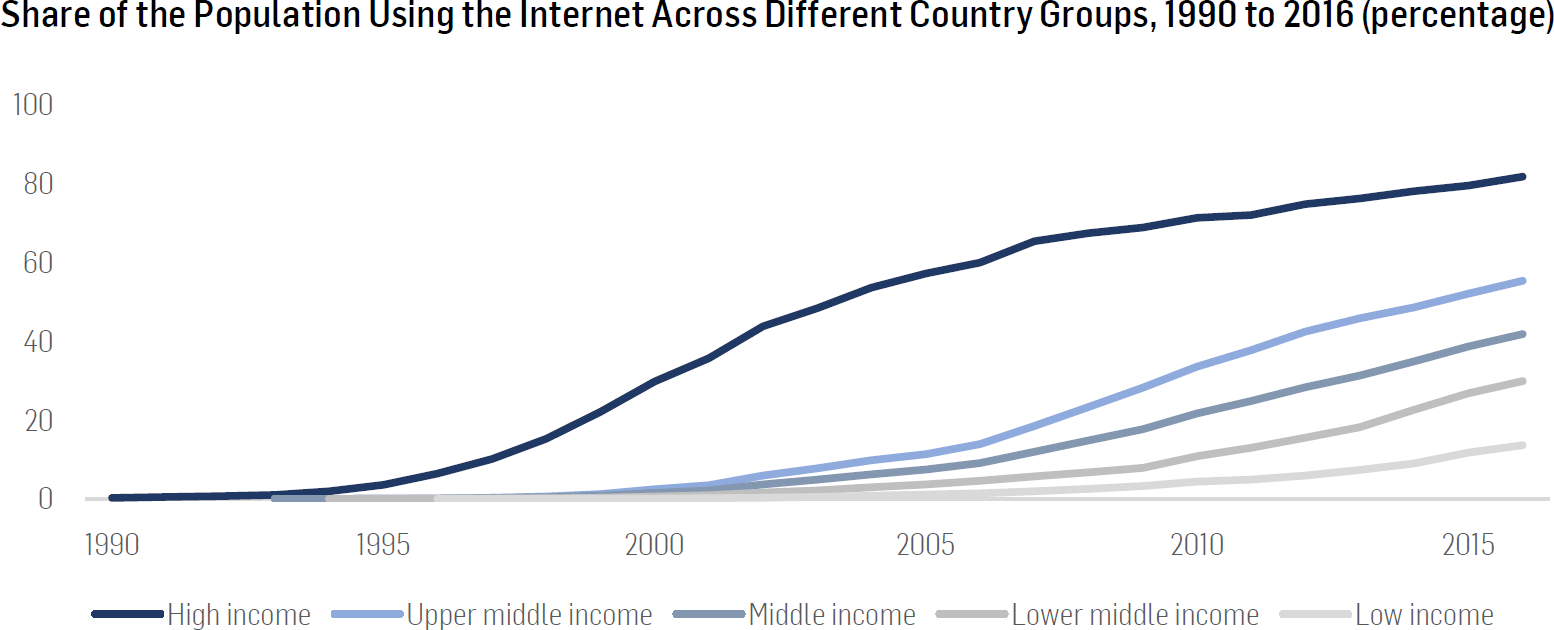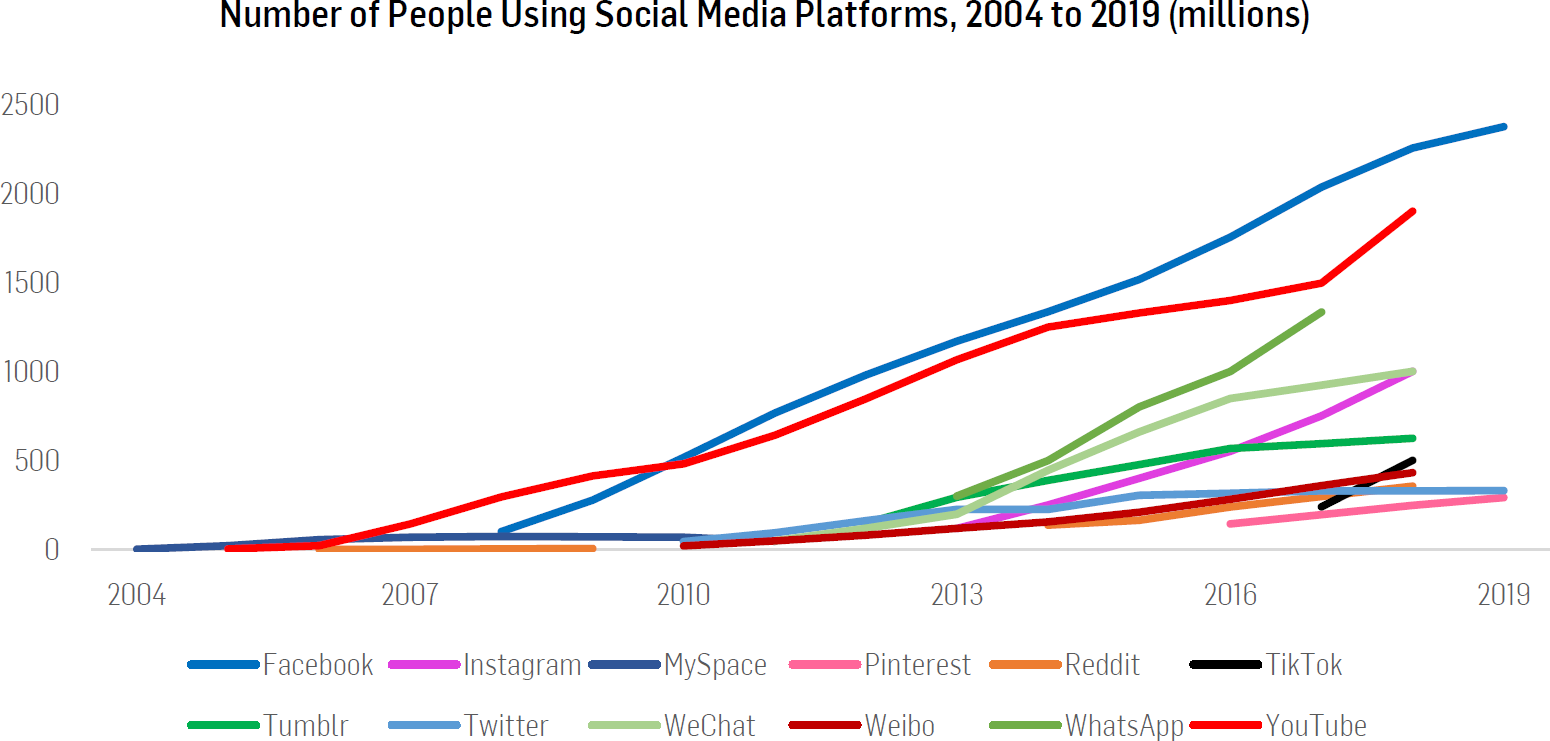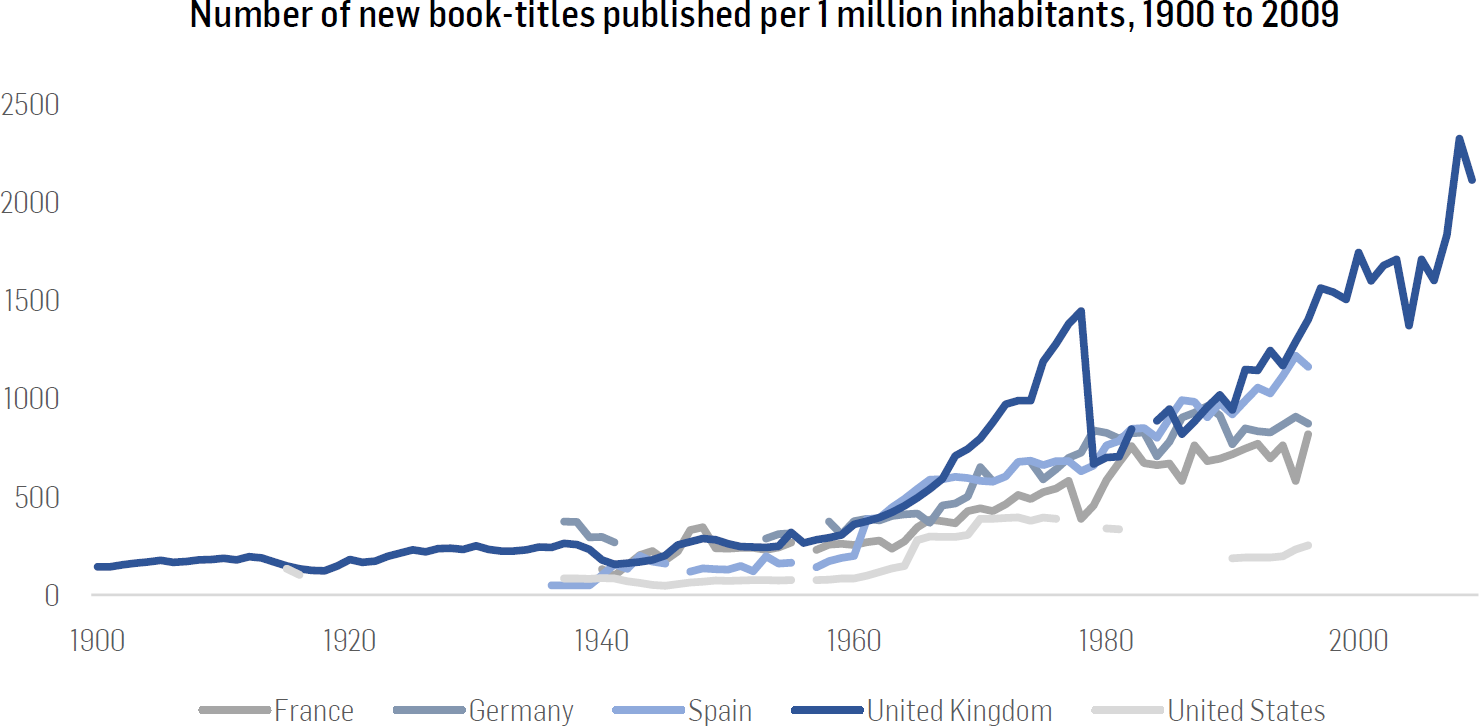Better Together: Solactive Connected Consumer Index
|
Advancements across multiple fronts have led us to be more interconnected than ever before. From top-artists performing live concerts through online video games, to prestigious universities offering some of their degrees completely online, technology is becoming ever-more intertwined with our daily lives. Given this fact, we have created the Solactive Connected Consumer Index. The index provides exposure to companies at the forefront of Home Entertainment, Virtual and Digital Interaction, Online Education, and Remote Health and Well-Being. This set of companies is set to be among the beneficiaries of the overall societal trend towards digitization. |
Introduction – Breaking Barriers by Building Connections
Almost three decades ago, Pearl Jam was in the midst of a boycott against Ticketmaster – the ticket sales and distribution company. The Seattle alt-rock band claimed that, due to the alleged monopoly power the California-based company had over major concert venues, ticket prices were inflated by a non-negligible amount due to opaque service fees charged by Ticketmaster. This altercation left the band on the hunt for alternative venues in order for it to hold its concerts, as most mainstream ones shut their doors to them. 1
Among the then-novel venues in which Pearl Jam ended up playing was the Empire Polo Club in Indio, California – about two hours away from Los Angeles – in November 1993. The concert was a hit: around 25,000 people ended up enjoying classics such as “Alive” and “Jeremy” that day. 2 This event proved the suitability of the Empire Polo Club to hold major events, a fact that was noticed by Paul Tollett over two decades ago, who subsequently chose the location as the ideal one to hold the Coachella Valley Music and Arts Festival – which eventually became the multi-million dollar making, record-breaking, festival that it is today. 3
However, Coachella’s meteoric rise in popularity did not make it immune to the Coronavirus Pandemic – which has hit the concert industry particularly hard and made the April 2020 event get cancelled. Nevertheless, this fact didn’t stop Travis Scott (one of the event’s headliners) showcasing his artistic talent during that same month on a tour held in a rather unusual location: Fortnite. 4 In a great display of artistic vision and creativity, the American rapper successfully held a set of virtual concerts meshed with Fortnite’s graphics – one of which drew a record 12.3 million live viewers and led to a fourfold increase in the streaming of the artist’s then-latest music video. 5
Even though Fortnite’s main target audience is composed of a generation of digital-natives, an overarching societal trend is clearly visible: our consumption patterns and channels are being changed dramatically on previously-unthinkable ways – partially due to innovations enabled by a larger degree of interconnectivity, as well as to an ever-increasing capacity to process and consume data. This change in consumption spans a wide array of areas: from how we spend our free time and keep ourselves healthy, to how we manage to continuously learn new skills. The fact that this is a seemingly unstoppable shift can be reflected by the sharp expected growth in global data volume during the next couple of years, from 33 zettabytes (ZB) in 2018 to 175 ZB in 2025. 6 The staggering growth rate in the number of internet users worldwide may serve as an additional tailwind for this trend. Between 1999 and 2016, the share of the population with internet access’ compounded annual growth rate was greater than 8% for high-income countries, and over 25% for upper-middle, middle, lower-middle, and low-income countries. 7

Source: ourworldindata.org and References Therein
The Solactive Connected Consumer Index – Four Major Pillars
Given how interconnected our day-to-day lives are becoming due to technological innovation across many fronts, we have created our Solactive Connected Consumer Index. Specifically, the index provides exposure to companies at the forefront of Home Entertainment, Virtual and Digital Interaction, Online Education, and Remote Health and Well-Being.
Home Entertainment
Investing in companies revolutionizing our channels of entertainment
Top thematic picks: Activision Blizzard and NetEase.
Our transition towards a more connected society can be noted markedly in our means of Home Entertainment. Namely, by digital-native companies, which are taking the media industry by storm. The ability of these kind of platforms to deliver content with a great degree of flexibility regarding timing and distribution channels is greatly undercutting traditional media players – which have consistently posted declines in viewership ratings over the past couple of years. Furthermore, the ability to access and analyze first-party customer preference and behavior data in order to customize content and target marketing represents an additional boost for companies like Netflix, which has determined that 75% of its user’s viewer activity is based on its suggestions. 8
The dominance of these relatively new players may further accentuate, as they ramp up their in-house production capabilities – which may eventually become a necessity for them, as traditional media groups gradually become their rivals rather than partners. The billions of dollars companies like Netflix are investing in production-related efforts will likely end up benefitting their over 160 million paid global subscribers. Particularly, analysts at Wells Fargo noted that for every dollar a consumer spends on a monthly Netflix account, he or she receives almost one billion dollars of content. 9
Another industry that has been consolidating its position within our households more and more is the videogaming one, which grew by 3% in 2019 to an over USD 120 billion sector. Free-to-play games, in particular, accounted for 80% of dollars spent on digital games in 2019, as they diminish initial barriers for new players, even though they willingly sacrifice upfront revenues in lieu of the longer-term opportunity to make money from usage – through microtransactions for in-game goods and services. 10, 11
Despite the fact that the subscription business model is not as prominent yet in the videogaming industry, its unique consumption model and economics still translate into a relatively high engagement by their userbase. Some examples of this fact are the almost two hours a day, on average, players invest in DotA 2, the more than an hour a day they play CS:GO, or the more than six hours a week that 70 percent of Fortnite players spend on the game. 11
Virtual and Digital Interaction
Investing in companies keeping us together even when far apart
Top thematic picks: Facebook and Snap.
One of the most common denominators of many popular videogames is that they enable a high degree of Virtual and Digital Interaction among their users. In fact, the interconnectivity they provide may be one of the key factors behind their success – given the importance of social interactions for people’s wellbeing. This hypothesis could be backed by multiple studies, which conclude that a greater degree of social interaction leads to longer and happier lives, and better mental health. 12 Therefore, it should come as no surprise that, as of 2018, Facebook has over 2.2 billion subscribers, YouTube around 1.9 billion, and that WhatsApp, Instagram, and WeChat have each already surpassed the 1 billion user hallmark. 13

Source: ourworldindata.org and References Therein
The broad impact social media giants have had over our societies can also be reflected in the remarkable growth of one of their main revenue streams: advertising revenues. In the advent of the millennium, the internet accounted for under 2% of ad spending. By 2020, digital marketing (excluding online ads sold by outlets such as news publishers or broadcasters) is predicted to account for more than half of the USD 530 billion global advertising industry. The difference of 2020’s expected ad expenditure growth between digital and traditional media reflects the outlook disparity among these two advertisement sources. Even though pure digital ad spending is expected to dip by 2.4% in 2020, that of traditional media (such as television, newspapers, and outdoor advertising) is expected to suffer a fall almost ten-times as large – at -20.7%. 14
Subscription-based platforms that seamlessly enable video interactions at scale, such as Zoom Video Communications, are set to profit from the digitization revolution as well. This type of companies’ growth may not only come from our urge to socialize but from the convenience their services facilitate across many different types of sectors as well.
Online Education
Investing in companies enabling the remote scalability of education
Top thematic picks: K12 and 2U.
One sector that clearly benefits from the development of video communication technologies is the education one – notably, regarding Online Education. 2U is a showcase of how innovative companies are revolutionizing the education landscape – which can be reflected by them offering the technology necessary for institutions as reputable as the London School of Economics, Georgetown University, or Northwestern University to offer undergraduate and/or graduate degrees, among others, fully online.
As the Coronavirus forces educational systems worldwide to offer classes online, their administrators may notice the efficiency gains that could be realized by adopting aspects of online teaching permanently. This outcome may particularly be the case regarding the scalability of online classes when it comes to reducing wage-related expenditures – which may be especially relevant given the labor-intensive nature of education. Notably, about half of the overall tertiary-level education’s current expenditure in the United States corresponds to instruction-related costs, while current expenditure represents between 90 and 97 percent of OECD countries’ total education expenditure across non-tertiary education levels. 15
The digitization process of traditional players in the publishing industry, such as John Wiley & Sons, may make the transition towards the digital classroom even more feasible, by unlocking the access to hundreds of thousands of publications made throughout history widely available to the broader public.

Source: ourworldindata.org and References Therein
Remote Health and Well-Being
Investing in companies allowing us to lead a healthier lifestyle through digital means
Top thematic picks: Teladoc Health and Peloton.
A greater degree of connectivity is also enabling many advances in the field of Remote Health and Well-Being. A clear beneficiary of this advancement is the telehealth industry. In 2019 11% of US consumers used telehealth. This figure skyrocketed post-COVID-19 to 46% – with providers seeing 50 to 175 times the number of patients via telehealth than they did before. If the telehealth industry manages to materialize its potential, McKinsey estimates that it may capture USD 250 billion of current US healthcare expenditure, up from the industry’s pre-pandemic USD 3 billion annual revenues. 16
Telehealth’s expansion will greatly be shaped by the advancement of complementary technologies to it. Clear examples of such technologies are electronic health records and wearables. As manufacturers of health-related devices (such as fitness trackers, smartwatches, and wearable blood pressure monitors, among others) become more sophisticated in their data gathering and analysis skills – as well as more able to store it into a centralized database – the more efficient will telehealth players be in providing an effective and well-informed service from the distance. The fact that over 80% of consumers are willing to wear fitness technology is particularly encouraging for the industry. 17 Subscription-based fitness- or wellness-related businesses such as Peloton may further contribute to the data-driven makeover of the healthcare industry.
The Solactive Connected Consumer Index – Index Construction and Characteristics
To obtain our company universe, we use ARTIS®, Solactive’s proprietary natural language processing software. ARTIS® stands for Algorithmic Theme Identification System. The algorithm identifies the thematic exposure of a broad set of companies by analyzing more than 500,000 text documents related to them, and determines their degree of thematic relevance based on theme-related keywords given to the algorithm as an input. In order to get the index’s constituents, we ran four separate ARTIS® queries (one for each of the aforementioned pillars) and picked the top-10 companies by thematic relevance of each one of them – after applying liquidity and industry filters.
The 40 components of the Solactive Connected Consumer Index are equal-weighted. The index is rebalanced on a semiannual basis, and all securities underlying it are listed on US regulated exchanges. The most heavily represented industry sectors in the index (as of its latest rebalance on the 11th of March 2020) are the Internet Software/Services, Other Consumer Services, and Packaged Software sectors. As of the index’s latest rebalance, its largest constituents (by security-level market capitalization) were Apple, Amazon, and Facebook, whereas its smallest ones were Huami, SmileDirectClub, and K12.
Top-5 Economic Sectors, Industry Sectors, and Companies (According to Security-Level Market Capitalization) of the Solactive Connected Consumer Index (as of the 11th of March 2020 Rebalance)
| Economic Sector | % | Industry Sector | % | Market Cap | USD bn. | ||
| Technology Services | 35.0 | Internet Software/Services | 22.5 | Apple Inc. | 1205.14 | ||
| Consumer Services | 25.0 | Other Consumer Services | 15.0 | Amazon.com, Inc. | 906.44 | ||
| Consumer Durables | 12.5 | Packaged Software | 12.5 | Facebook, Inc. Class A | 409.55 | ||
| Health Services | 10.0 | Recreational Products | 7.5 | Alphabet Inc. Class A | 363.14 | ||
| Electronic Technology | 5.0 | Medical/Nursing Services | 7.5 | Comcast Corporation Class A | 172.25 |
Final Remarks
A never-ending string of innovations is molding global societies on an unprecedented scale. New technologies are unlocking previously unattainable possibilities, which are – in turn – making our lives much more interconnected and efficient. The Solactive Connected Consumer Index provides exposure to companies offering innovative services and technologies in the fields of Home Entertainment, Virtual and Digital Interaction, Online Education, and Remote Health and Well-Being. This set of companies could be among the beneficiaries of the secular trend of digitization – thus, potentially further benefitting their investors in the process.
Dr. Axel Haus, Team Head Qualitative Research
Javier Almeida, Qualitative Research Analyst
Solactive AG
References
[1] Boehlert (1995): “Pearl Jam: Taking on Ticketmaster”
[2] Hochman (1993): “Pop: Pearl Jam Blossoms in Desert”
[3] Seadbrook (2017): “The Mastermind Behind Coachella”
[4] YouTube (2020): “Travis Scott and Fortnite Present: Astronomical (Full Event Video)”
[5] Lewis and Inagaki (2020): “Sony invests $250m in Fortnite’s Epic Games”
[6] Reinsel, Gantz, and Rydning (2018): “The Digitization of the World: From Edge to Core”
[7] Ritchie, and Roser (2017): “Technology Adoption”
[8] Dennehy, and Kim (2019): “Hollywood’s Streaming Angst”
[9] Nicolaou, and Barker (2019): “Online streaming: Television’s looming car crash”
[12] Ortiz-Ospina, and Roser (2020): “Loneliness and Social Connections”
[13] Ortiz-Ospina (2019): “The rise of social media”
[14] Barker (2020): “Digital ad market set to eclipse traditional media for first time”
[15] Roser, and Ortiz-Ospina (2016): “Financing Education “
[17] Phaneuf (2020): “Latest trends in medical monitoring devices and wearable health technology”
